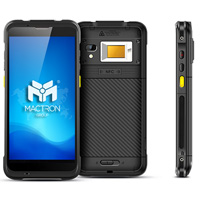Fingerprint scanners have become vital to modern life, effortlessly identifying individuals with a single touch. Exploring the technology behind them and their potential applications reveals their significant impact on various aspects of our daily lives.
Fingerprint Scanner
Fingerprints are distinctive friction ridge patterns on fingers, that serve as durable and intricate identifiers. Fingerprint scanners, crucial components of Biometrics security systems, utilize diverse recognition technologies in police stations, security sectors, smartphones, and mobile devices. These scanners capture and analyze fingerprint data using unique principles and sensor systems, guaranteeing precise identification and authentication. Here's an overview of each type's operating principle:
Optical:
Capacitive fingerprint recognition relies on the electrical properties of human skin. A sensor array detects electrical variances between ridges and valleys on the fingerprint's surface. When a finger touches the sensor, capacitance at each pixel is gauged, forming a unique fingerprint image from capacitance variations.

Advantages:
- Cost-effective: Optical scanners provide a budget-friendly alternative compared to other types.
- Ideal for essential security: They effectively fulfill basic authentication needs.
- User-friendly: They typically offer an intuitive experience and straightforward setup process.
- Lower resolution: Optical scanners may have reduced resolution, resulting in less accurate scans compared to other types.
- Susceptible to environmental factors: Wet, dry, or aged fingers may pose issues with image capture due to variations in reflective properties.
Capacitive:
Capacitive fingerprint recognition relies on the electrical properties of the human skin. A capacitive sensor array detects the electrical differences between ridges and valleys on the fingerprint's surface. When a finger is placed on the sensor, the capacitance at each pixel is measured, creating a unique fingerprint image based on the variations in capacitance.

Advantages:
- Higher security: Capacitive scanners are generally more secure compared to optical scanners.
- Better accuracy: They provide higher-resolution scans, leading to more accurate authentication.
- Less affected by external factors: They are less affected by dirt, moisture, or lighting conditions.
- Higher cost: Capacitive scanners are typically more expensive due to their advanced technology.
- Limited to certain materials: They work best with conductive materials, limiting the types of surfaces they can be integrated into.
Ultrasonic:
Ultrasonic fingerprint recognition utilizes ultrasonic waves to generate a 3D image of the fingerprint's subsurface features. A transducer emits ultrasonic waves that penetrate the skin and bounce off unique fingerprint characteristics like ridges and pores. The sensor captures these reflections, forming a detailed 3D fingerprint image for authentication.

Advantages:
- Highly secure: Ultrasonic scanners provide heightened security by capturing detailed 3D fingerprint images.
- Spoofing resistance: They are less susceptible to spoofing compared to optical and capacitive scanners.
- Works through materials: Ultrasonic scanners can penetrate thin materials like glass or plastic, offering design flexibility.
- Cost: Ultrasonic scanners are often pricier due to their advanced technology.
- Power consumption: They may drain more power, impacting battery life in mobile devices.
- Complexity: The technology behind ultrasonic scanning is more complex, which may result in higher maintenance costs and potential integration challenges.
Advantages of using fingerprint scanner in Industrial PC

Advantages of Fingerprint Scanners in Industrial PCs:
- Enhanced Security: Fingerprint scanners offer Biometrics authentication, difficult to spoof, ensuring higher security compared to passwords.
- Convenience and Efficiency: Users find fingerprint authentication convenient, eliminating the need for password memorization or physical tokens, thereby speeding up login processes.
- Reduced Risk of Unauthorized Access: Fingerprint authentication limits access to authorized personnel only, minimizing the risk of unauthorized entry, data breaches, and sabotage.
- Integration with Access Control Systems: Fingerprint scanners seamlessly integrate with access control systems, enabling effective enforcement of security policies, user access tracking, and audit trail maintenance.
- Compliance with Regulations: Fingerprint authentication helps organizations comply with industry-specific data security, privacy, and access control regulations, enhancing regulatory compliance.
The choice of fingerprint scanner depends on security requirements, budget, environmental conditions, and intended use. Each type has unique strengths and weaknesses, necessitating careful consideration during selection.
 |  |
Check out MACTRON GROUP(MTG)’s MCA0556 & MCA0806 products. Both of them supports capacitive fingerprint, and MCA0806 support both capacitive and optical fingerprint module. They will become powerful tools to help you manage employee identification and information security.
